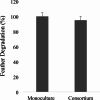Enhancing spinach growth with a biofertilizer derived from chicken feathers using a keratinolytic bacterial consortium
- PMID: 40211114
- PMCID: PMC11983857
- DOI: 10.1186/s12866-025-03866-z
Enhancing spinach growth with a biofertilizer derived from chicken feathers using a keratinolytic bacterial consortium
Abstract
This study was conducted to develop a cost-effective and environmentally friendly biofertilizer by utilizing chicken feather waste. Two bacterial strains were employed to biotransform the abundant keratin protein in feathers. The keratinolytic bacterial strains used in this study were identified as Bacillus licheniformis MW45 and Bacillus paralicheniformis MW48. The feather hydrolysate was assessed for its effectiveness as a nitrogen fertilizer with slow-release properties. The study employed a completely randomized design (CRD) with three replicates, and statistical analysis, including ANOVA followed by Tukey's test, was used to validate the differences between treatments. The test plant was spinach, and various growth parameters were observed. The growth promotion activity of the produced biofertilizer was compared with a commercially available NPK fertilizer. The results showed that the growth promotion effect of chicken feather hydrolysate was significantly higher than the control and commercially available NPK fertilizer. The feather hydrolysate displayed the highest germination percentage (48%), vigor index (1081.44), number of leaves (17), height (22.53 cm), and weight (3.493 g), compared to the chemical fertilizer's germination percentage (31%), vigor index (714.4), number of leaves (13), height (18.5 cm), and weight (1.904 g). Statistical analysis showed that the fermented chicken feather hydrolysate can be effectively applied as a slow-releasing nitrogen fertilizer in agricultural fields. The novelty of this study lies in the use of a bacterial consortium to transform chicken feathers into high efficiency biofertilizer. This production may not only supports the national economy by increasing crop yield but also contributes to a cleaner and greener Pakistan by recycling feather waste.
Keywords: Biofertilizer; Corncob; Feather waste; Immobilization; Keratin hydrolysate; Keratinase; Spinach plant.
© 2025. The Author(s).
Conflict of interest statement
Declarations. Ethical approval: The study used spinach seeds collected from a local nursery and processed in the laboratory at the Department of Microbiology, according to the guidelines and regulations of the University of Karachi and no additional ethical approval was required for this study. Consent for publication: Not applicable. Informed consent: Not applicable. Competing interests: The authors declare no competing interests. Statement of human and animal rights: Not applicable.
Figures




Similar articles
-
Feather degradation by keratinolytic bacteria and biofertilizing potential for sustainable agricultural production.J Basic Microbiol. 2019 Jan;59(1):4-13. doi: 10.1002/jobm.201800434. Epub 2018 Oct 24. J Basic Microbiol. 2019. PMID: 30353928 Review.
-
Characterization of a Bacterial Keratinolytic Protease for Effective Degradation of Chicken Feather Waste into Feather Protein Hydrolysates.Front Biosci (Elite Ed). 2024 Jul 9;16(3):22. doi: 10.31083/j.fbe1603022. Front Biosci (Elite Ed). 2024. PMID: 39344376
-
Bioconversion of feather waste into bioactive nutrients in water by Bacillus licheniformis WHU.Appl Microbiol Biotechnol. 2023 Dec;107(23):7055-7070. doi: 10.1007/s00253-023-12795-8. Epub 2023 Sep 26. Appl Microbiol Biotechnol. 2023. PMID: 37750916
-
Keratinase production and biodegradation of whole chicken feather keratin by a newly isolated bacterium under submerged fermentation.Appl Biochem Biotechnol. 2012 Jul;167(5):1040-51. doi: 10.1007/s12010-011-9527-1. Epub 2012 Jan 14. Appl Biochem Biotechnol. 2012. PMID: 22246728
-
Chicken Feather Waste Hydrolysate as a Superior Biofertilizer in Agroindustry.Curr Microbiol. 2021 Jun;78(6):2212-2230. doi: 10.1007/s00284-021-02491-z. Epub 2021 Apr 26. Curr Microbiol. 2021. PMID: 33903939 Review.
References
-
- Wang B, Yang W, McKittrick J, Meyers MA. Keratin: structure, mechanical properties, occurrence in biological organisms, and efforts at bioinspiration. Prog Mater Sci. 2016;76:229–318. 10.1016/j.pmatsci.2015.06.001.
-
- LEBLOND CP. The keratinization of epidermis and its derivatives, especially the hair, as shown by x-ray diffraction and histochemical studies. Ann N Y Acad Sci. Mar. 1951;53(3):613–26. 10.1111/j.1749-6632.1951.tb31963.x. - PubMed
MeSH terms
Substances
LinkOut - more resources
Full Text Sources

